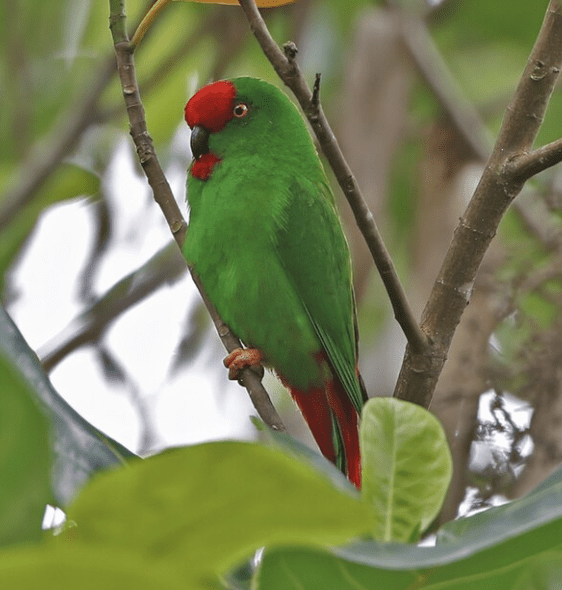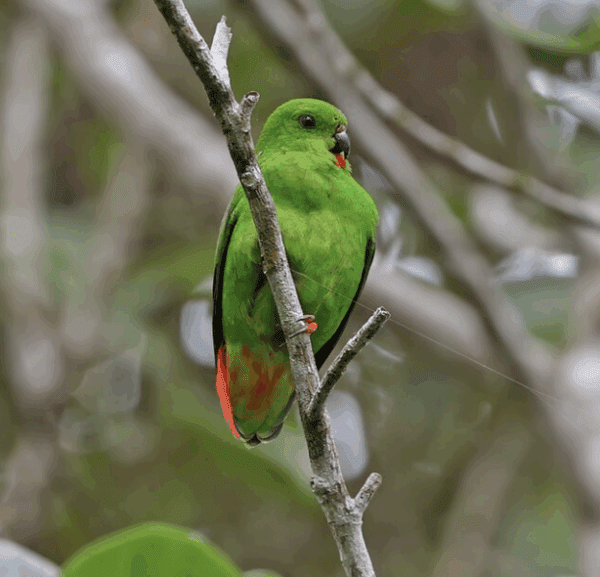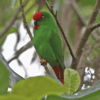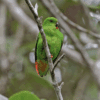Sangihe Hanging Parrot
Also known as:
Sangir Hanging Parrot
Also known as:
Sangir Hanging Parrot

Loriculus

catamene
Size:
12 cm (4.7 in)
Weight:
Not recorded.
Subspecies including nominate:
one
Colour Adult:
Male-in general plumage green; red forehead and forecrown; back and lower mantle tinted with orange/yellow; red chin and throat; carpal edge of wing yellow/green; red rump and upper tail coverts, the latter reaching to tip of tail; undertail coverts orange/red thinly margined with green; tail green tipped with red. Beak black. Eye yellow/white. Female-green crown; red spots on forehead, and irregular red spots on throat. Eye brown.
Colour Juvenile:
As in female. Eye pale brown.
Call:
Unusual and high-pitched trilling with sharp beginning note. Also single notes given in flight.
More Information:
Content Sources:
CITES
Birdlife International
Cornell Lab of Ornithology/Birds of the World
Parrots: A Guide to Parrots of the World, Juniper and Parr, 1998
Parrots: Status Survey and Conservation Plan 2000-2004, Snyder, McGowan, Gilardi and Grajal, 2000.
Parrots of the World, Forshaw and Cooper, 1977. 2010 edition
Parrots of the World, Forshaw, 2006.
Lexicon of Parrots, Thomas Arndt.
Parrots in Aviculture, Low, 1992.
Captive Status:
Not usually found.
Longevity:
—
Housing:
Planted aviary, 2.5 x 1 x 2 m (8.2 x 3.3 x 6.5 ft), or spacious bird-room enclosure, with concrete floor and drain if possible, for ease of cleaning.
Diet:
Fruits such as: banana, apple, pear, orange, cactus fruits, pomegranate; vegetables such as: carrot, celery, peas and beans; lory formula, either commercial or home-made fresh daily; seed mix such as: millet, canary, niger; spray millet (sprouted), eggfood and mealworms for chick-rearing.
Enrichment:
Unsprayed fruit-tree branches with blossoms, also willow and elder branches; shallow bowls of water for daily bathing.
Nest Box Size:
Nest log 5″ x 12″ (12.7 cm x 30.5 cm)
Clutch Size:
2
Fledging Age:
5 weeks, as in other Loriculus sp.
Hatch Weight:
—
Peak Weight:
—
Weaning Weight:
—
World Population:
6700-31,000 mature individuals, decreasing.
IUCN Red List Status:
Near Threatened
CITES Listing:
Appendix II
Threat Summary:
Not globally threatened. Restricted-range species; occurs in Sangihe and Talaud Endemic Bird Areas. Large-scale forest clearance continues to be a threat. There appears to be little evidence for a continuing decline given its apparent tolerance of secondary habitats. Further potential threats are the widespread clearance of large isolated trees, which was linked to declines in the 1980s, disease transmitted by escaped parrots and future volcanic activity.
Range:
Sangihe Island, Indonesia.
Habitat:
Found on most wooded areas of cultivated island, including remnant forest patches, mixed plantations, abandoned gardens; not known if survival is possible without presence of primary forest. Up to 900 m (2952 ft).
Wild Diet:
Main food source coconut nectar. Nectar of Lansium domesticum and Ficus fruits also taken. May also take invertebrates.
Ecology and Behaviour:
Seen in pairs or small groups around coconut flowers and flowering shrubs. Resident. Less conspicuous than most hanging parrots.
Clutch and Egg Size:
2 rounded eggs, 17.0 x 14.5 mm (0.7 x 0.6 in).
Breeding Season:
Possibly May. Nest is in tree cavity.
Related Links:
—



